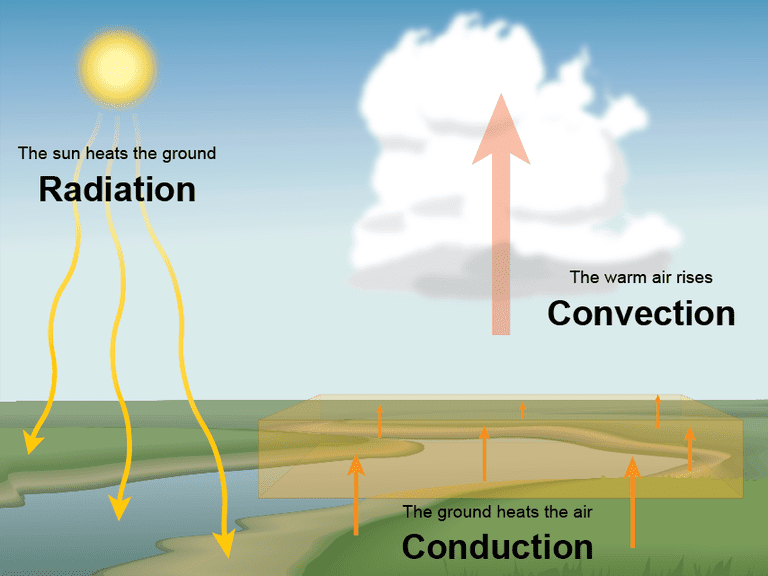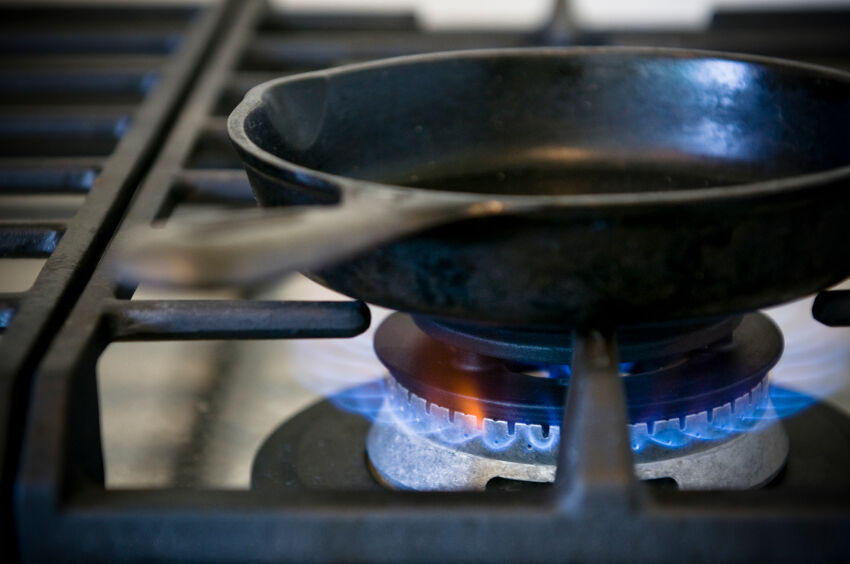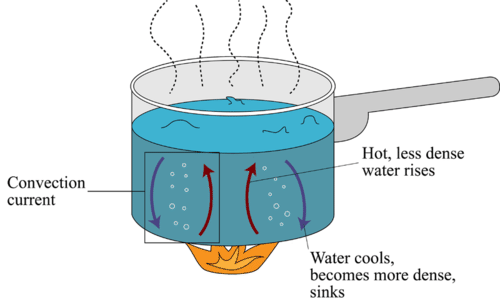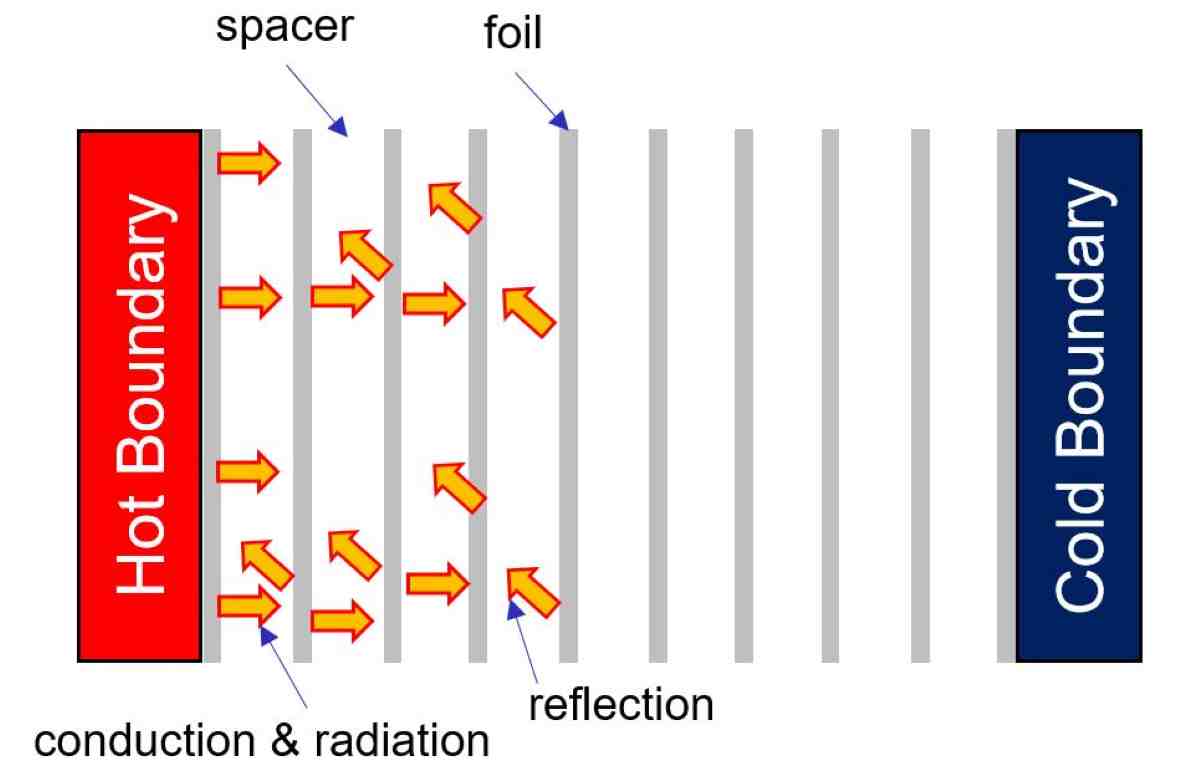What is conduction convection and radiation? (With example)- Heat transfer is involved in so many processes that it is difficult to imagine a situation in which there is no heat transfer taking place. However, every heat transfer process involves only three methods: Conduction, Convection, and Radiation.
In addition to the effects heat transfer has on a system, understanding how it occurs is also fascinating. The transfer of heat occurs whenever a temperature difference exists. As an example, heat can be transferred quickly through a cooking pan, or at a slower pace through the walls of an ice chest when one is having a picnic. Choosing materials (like thick wool clothing in the winter) or controlling air movement (such as using weather stripping around doors) can reduce heat transfer rates. Color can also influence heat transfer rates (such as a white roof reflecting sunlight).
Linquip provides a wealth of information on heat transfer and its applications. Different heat transfer methods are used in many of the everyday devices and equipment we use. See Linquip’s “Heating” page for more information about heating devices and tools.
With so many models available on the market, it may be challenging to choose the right heating device for your needs. You can pick Heating Products from a variety of options with Linquip. The Linquip platform also allows you to obtain quotes from a variety of Heating Companies and Suppliers for free.
The basic principles of heat transfer are temperature and flow of heat. A temperature determines how much thermal energy is available, and a heat flow represents how much thermal energy moves.
Molecules’ kinetic energy is directly correlated with their thermal energy on a microscopic level. The molecules become more agitated as the temperature rises, manifesting as linear motion and vibration. Energy is transferred from regions with higher kinetic energy to those with lower kinetic energy. It is possible to categorize heat transfer into three broad classifications: conduction, convection, and radiation. The purpose of this post is to provide an overview of all three methods of heat transfer so that you can better understand them.

Conduction
Heat is transferred through conduction by direct molecular collisions. Heat will be transferred from an area with greater kinetic energy to a region with lower kinetic energy. Particles with higher speeds will collide with those with lower speeds. The slower-speed particles will gain kinetic energy in this way. The most common method of transferring heat is conduction, which occurs through physical contact. For example, you could place a metal object into an open flame or place your hand against a window.
A heat conduction process is influenced by a number of factors: temperature gradient, cross-section of the object, traveling distance, and the physical characteristics of the material. Heat travels in a specific direction and rate based on the temperature gradient. The flow of temperature will always go from hottest to coldest or, as previously stated, from highest to lowest kinetic energy. As soon as the temperature differentials reach thermal equilibrium, thermal transfer ceases.
The path of travel and the cross-section both play a significant role in conduction. An object’s size and length determine how much energy it takes to heat it. In addition, the greater the exposed surface area, the greater the loss of heat. Smaller cross-sectioned objects lose less heat than larger objects.
The physical properties of materials determine how well they transfer heat. For example, when it comes to conduction, metal materials conduct heat more effectively than cloth because of their higher thermal conductivity coefficients.

Examples
The following are some examples of conduction heat transfer:
- The act of touching a stove: As a result of heat transfer between stove and hand, our hands are burnt after touching the stove at higher energy levels.
- The cooling effect of ice on your hand: Because ice is colder than our fingers, it absorbs heat from our hands. Thermal conduction occurs between our hands and the ice block.
- The shallow frying of foods like cutlets: Heat is transferred from the pan to the cutlet during shallow frying. Between the pan and the cutlet, thermal conduction occurs.
- Warming of muscles with a heating pad: Heating pads contain high-energy molecules, which transfer energy to the skin and muscles. Once the heat is applied to our muscles, we feel relaxed. Thermal conduction is also evident here.
- A cup gets hot from liquid heat: Heated molecules move with a high level of energy, and that energy is transferred to the cup’s surface, as it is in contact with the liquid.
- Stepping on hot sand: Our feet get hot when we walk on hot sand. This is why we burn our feet when walking on sand with high temperatures. Thermal conduction contributes to this.
- The touch of a light bulb: Light bulbs are very hot. Touching a light bulb transfers the heat to our hands, causing us to feel warm.
Convection
The thermal energy is carried along with a fluid, such as air or liquid, when it is heated and moves away from the point of origin. Convection is the transfer of heat in this manner. As a hot surface expands, the fluid above it becomes less dense and flows upward.
At the molecular scale, thermal energy causes molecules to expand. In proportion to the temperature of a given fluid mass, the volume of the fluid increases as well. When the fluid is affected in this way, displacement occurs. Hot air rises and pushes denser, colder air downward.
A space heater is a classic example of convection. During the heating process, the air surrounding the space heater near the floor will become warmer, expand, and rise to the ceiling. Thus, convection currents are created when cooler air is forced downward.
Single- or multiphase fluids flow spontaneously from heterogeneous material properties combined with body forces, most commonly gravity and density. Convection can be assumed to occur due to thermal expansion and buoyancy when the origin of convection is not specified. A soft solid or mixture with particles that are capable of flowing can also undergo convection.
A convective flow can be transient (as when an oil-and-water mixture separates) or steady. Convection may be caused by gravitational forces, electromagnetic fields, or fictitious bodies. A large part of the structure of the Earth’s atmosphere, oceans, and mantle is due to heat transfer through natural convection. Thunderstorms form when strong convection occurs in the atmosphere. Stellar physics also involves natural convection. There are a variety of ways in which convection can be classified or described, such as by the main cause of the convection, such as Thermal convection.
Since bulk current flows and significant diffusion of matter cannot occur in most solids, convection cannot occur. A similar concept, granular convection occurs in granular substances rather than fluids. Advection refers to fluid motion caused by velocity instead of thermal gradients.

Forced Convection
It is more common to use forced convection inside houses rather than natural convection. By using a fan, air currents are forced throughout a room. The effects of forced convection are the same as natural convection, it is merely aided by devices like fans. The forced convection in your house can be seen in the heating vents on your walls.
Example
These are a few examples of routine convection heat transfer:
- A traditional radiator: emits warm air at the top of a room and draws in cool air at the bottom.
- Boiling of water: Boiling water involves convection. As the energy from the burner heats up the water at the bottom, it rises. This results in a circular motion as the hot water rises and replaces it with cold water.
- Melting of ice: Convection occurs when the ice melts. When warm air blows over the surface or the boundary of ice, the temperature of the surface or boundary rises; or when water, which has a higher temperature than ice, flows beneath the surface. Ice melts as its surface or boundary temperature changes. The same applies to frozen materials that thaw in water.
- Breeze: A classic example of convection is the formation of a sea breeze or a land breeze. As per the convection definition, molecules at higher temperatures displace molecules at lower temperatures. It is warmer near the sea in the afternoon than in the evening. As a result of convection, the air close to the surface of the earth heats and rises. Cool air quickly replaces this warm air near the land, resulting in the “Sea Breeze.” At night, the land cools down more quickly. In contrast, the air above seawater is warm and rises. Once this air ascends, cool air from the land replaces it, a phenomenon known as Land Breeze.
- The circulation of blood in warm-blooded mammals: It might surprise you to learn that warm-blooded animals regulate their body temperature through convection. The human heart acts like a pump and the blood circulates in the body by forced convection. As a result of the cells in the body generating heat, the pores in the skin transfer it to the air or water flowing over them.
- Air Conditioner: A hot summer day requires the constant use of an air conditioner. Air-conditioners use convection to cool air. By using air-conditioners, cold air is released. Due to its density, cold air sinks more than warm air. Due to its lower density, warm air rises, which is drawn in by air conditioners. This creates a convection current and cools the room.
- Refrigerator: Refrigerators work in a similar way to air conditioners. In refrigerators, the freezer is located at the top. As mentioned above, warm air rises since it is less dense and is, therefore, cooled by the freezer. As this cool air is denser, it sinks, keeping the lower part of the refrigerator cool.
- Hot Air Balloon: Convection is responsible for hot air balloons’ ability to rise. There is a heater underneath the balloon that you may have seen. By heating the air, it moves upwards. As a result, hot air which rises gets trapped beneath the balloon, causing it to rise. In order to land the hot air balloon, the pilot releases some of the hot air. Due to the replaced cold air, the balloon lowers as it exhales hot air.
Radiation
Emission of electromagnetic waves generates thermal radiation. Energy is carried away from the emitting object by these waves. It is possible for radiation to pass through a vacuum as well as transparent media (solid or fluid). As atoms and molecules move randomly in the matter, thermal radiation is produced. During the movement of charged protons and electrons, electromagnetic radiation is emitted.
Thermal energy is radiated by all materials based on their temperature. In general, the hotter an object is, the more radiation it will emit. A clear example of heat radiation is the sun, which transfers heat throughout the solar system. Normal room temperatures cause infrared waves to radiate from objects. The wavelength and frequency of the radiated waves are affected by the temperature of the object. In the presence of increasing temperature, the wavelengths within the spectrum of the radiation produce shorter wavelengths at higher frequencies.
In a solar cell, the photovoltaic effect transforms light energy into electrical energy. By absorbing light and exciting the electron, an electric potential is created and an electric current is generated. In recent years, solar panels have become more efficient.
An object’s emissivity is its ability to emit heat as thermal radiation. Based on the Stefan-Boltzmann law, it is the ratio of thermal radiation from a surface to that from an ideal black surface at a given temperature.

Infrared, Visible, Ultraviolet
Infrared, visible, and ultraviolet wavelengths are all components of thermal radiation. Each of these three types of radiation is emitted by the sun. Electromagnetic radiation is produced by any object that has a temperature above absolute zero. The electromagnetic spectrum consists of a wide variety of waves with different lengths.
The wavelength of an ultraviolet wave is about 900-3000 angstroms, whereas the wavelength of a visible light wave is 4,000-8,000 angstroms. The wavelength of an infrared wave is measured in microns. One micron is equal to 10,000 angstroms. The most energetic light in the visible spectrum is blue light, while the least energetic is the red light.
The radiation rate is proportional to the fourth power of an object’s Kelvin temperature. Thus, hotter materials emit more radiant energy. The net radiation heat transfer is the difference between the radiation leaving one surface and the radiation arriving from another surface. Energy is transferred at the speed of light.
Examples
Radiation can be found in everyday life in the following examples:
- Microwave oven: Using a microwave oven to transmit electromagnetic waves.
- Radiator: The thermal radiation emitted by a radiator.
- Sun: Solar ultraviolet radiation is the primary determinant of Earth’s temperature.
- Lamp: A lamp that emits incandescent light.
- Fire: We feel the heat of fire through radiation when we sit beside a fire.
- Refrigerator: In order to keep our refrigerator cool, the cooling fins behind the refrigerator must radiate their heat rapidly. It has a rough surface and is painted black.
- Clothes: Wearing white or light-colored clothes during hot summer days is recommended. Dark colors absorb more heat than white colors.
- Greenhouses: For the better growth of plants in cold areas, greenhouses are used. Solar radiation warms the soil and plants when it penetrates through glass or plastic. Radiation is absorbed and emitted by plants and soil in greenhouses, increasing the temperature. The greenhouse’s increased temperature promotes plant growth.
- Vacuum flasks: Liquids inside vacuum flasks are kept warm by minimizing heat loss through conduction, convection, and radiation. A vacuum between the double glass walls prevents conduction and convection through the sides of the flask. Since air is a very poor conductor of heat, there is very little conduction through trapped air above the liquid. Heat is also poorly conducted by the stopper, which is typically made of plastic. It is only following the removal of the plastic stopper that convection occurs. As radiant heat can pass through a vacuum, it is harder to stop heat loss by radiation. As a means of minimizing the loss of heat through radiation, silver is applied to the glass so that heat can be reflected back into the liquid.
- Teapots: Shiny teapots emit less radiation than black teapots, so they keep tea warmer for longer than black ones.
Multilayer insulation (MLI)
In general, insulations designed to minimize conduction and convection are less efficient at blocking radiant energy. Using vacuum insulators reduces conduction and convection because both methods of heat transfer rely on molecule interactions. A vacuum, however, allows radiant energy to pass through. It is necessary to use advanced thermal insulation solutions in order to reduce radiant heat transfer.
A prime example is multilayer insulation (MLI). Superinsulation is another name for it. The performance of MLI is best when it is performed in a vacuum. It is made up of layers of highly reflective material that are kept apart by separating materials. Insulation is more effective when there are more reflective layers. Performance is increased through the use of proprietary materials and designs.
Multi-layer insulation is used in a wide range of applications across a wide range of sectors, such as aerospace, engineering, healthcare, and industrial food processing. MLI is capable of being deployed in extremely cold or extremely hot conditions. Pipes and tanks are wrapped with it in cryogenic systems, such as those used to produce liquefied natural gas (LNG). In a vacuum annulus, MLI packages are capable of operating at temperatures up to 1000°C.
MLI is popular for thermal systems that require ultra-high insulation performance. Additionally, layer density can be customized based on the application. It’s common for designers to widen the vacuum space in order to accommodate additional layers.

Download PDF for Conduction, Convection, and Radiation
By clicking on the link below, you can download this article in PDF format for future reference and reading.
linquip.com-What Is Conduction Convection and Radiation
Buy Equipment or Ask for a Service
By using Linquip RFQ Service, you can expect to receive quotations from various suppliers across multiple industries and regions.
Click Here to Request a Quotation From Suppliers and Service Providers
Read More on Linquip
- What is Septic Tank and How Does It Work? The Ultimate Guide
- How to Plumb and Install an Expansion Tank?
- Difference Between Cell and Battery: Ultimate Guide
- What is the Difference between Heat and Temperature?
- Why DC Current Is Not Used In Homes
- Ways to Conserve Energy: General and Practical Solutions for Saving Energy
- Understanding the Workings of a Septic Tank: A Comprehensive Guide



